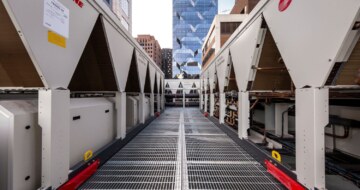
October 8, 2025 in Advisory Notes
Navigating Heat Pump Retrofits - A Guide for Facility M...
Electrification projects can be complex undertakings bringing together a range of technical elements along with planning, coordination and logistics c...
February 20, 2018
With heightened concerns around water usage, rising costs and environmental awareness there is an increased community consciousness in relation to unnecessary water consumption. While water-based fire protection systems are designed to be operated only when there is a fire, these need to be regularly inspected and tested to help ensure they will operate when needed. Inspection and testing regimes confirm both the operation and performance of the systems and although necessary, this generally consumes potable water.
There are a number of worthwhile initiatives that can be considered to reduce water consumption when testing or altering operational fire sprinkler systems or other water-based fire protection systems, such as fire hydrant & fire hose reel systems.
This initiative is applicable to systems that have booster pumps to achieve the required system performance. Over time it has been found that many fire pump pressure relief valves aren’t set properly, operating too early and unnecessarily discharging water during regular weekly/ monthly testing. There are four main areas of focus for this initiative:
The 2005 revision to the Australian Standard AS1851 Fire System Maintenance series of standards provided an option to adopt monthly testing in lieu of weekly frequency, as traditionally has been required. Further, the 2012 revision now does not refer to weekly testing at all. Adopting monthly testing in lieu of weekly testing has the obvious water saving advantage of conducting only 12 monthly tests in lieu of 52 weekly tests saving around 75% of the water used in this component of the maintenance regime.
Similar to pressure setting adjustment the objective of this initiative is aimed at avoiding operation of pressure relief valves by reducing the operating pressure of the pump where the pump duty significantly exceeds the system requirement.
This initiative comprises installation of a recirculation system to capture water discharged during a test and re-circulate it back into the system. This initiative is applicable to pump boosted systems which are suitable for pressure setting adjustment or pressure reduction initiatives.
Water from testing activities can be captured and re-used for other purposes including as:
Alterations to fire sprinkler systems normally require the water in the system to be drained down. For buildings that undergo regular changes this can result in a significant quantity of water use when draining and refilling the system. By installing subsidiary stop valves and/or check valves to zone the system, coupled with local drain valves in each zone, this avoids the need to drain the entire system when work is to be undertaken in only one part of the building. It also has an increased safety benefit in minimising the area of the system that is impaired.
This is a non-physical initiative using management principles to plan, monitor and review system modifications to reduce the need for system drain-down. Strategies include:
The suitability of each of these initiatives will vary from site to site and from system to system, however the first three initiatives are likely to be the most cost effective to implement for a majority of buildings.
Further insights are available from the Victorian Building Authority (VBA) “Practice Note” titled; PN 2007 – 61 Water Saving Options Available When testing Fire Safety. It can be downloaded from the Plumbing Industry section of the VBA website, www.vba.vic.gov.au.
download pdf
October 8, 2025 in Advisory Notes
Electrification projects can be complex undertakings bringing together a range of technical elements along with planning, coordination and logistics c...

September 1, 2025 in Advisory Notes
Cyber security incidents reported against both government and private organisations continue to increase in both frequency and severity.

July 15, 2025 in Advisory Notes
During COVID-19 many buildings experienced a significant reduction in the number of occupants. With the move to remote working, the reliance on tenant...

March 20, 2025 in Advisory Notes
We depend on the reliable supply of electrical power to support the operation of important systems in buildings. With the move to electrify gas powere...